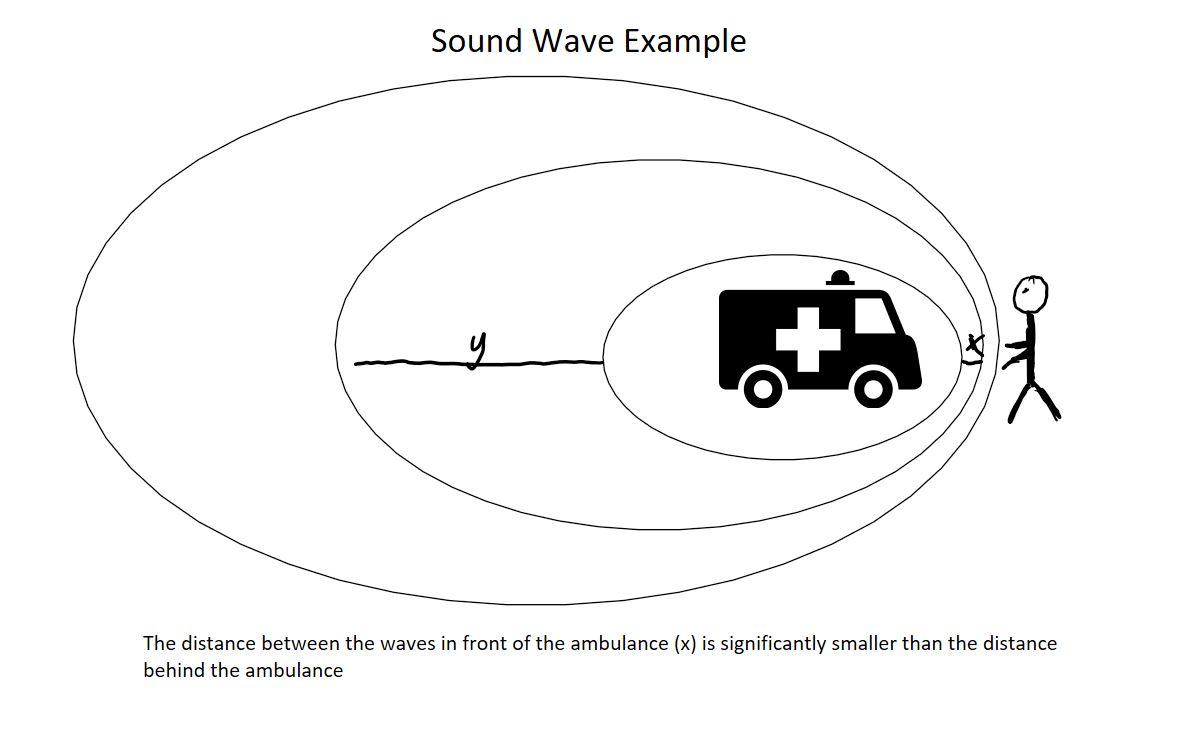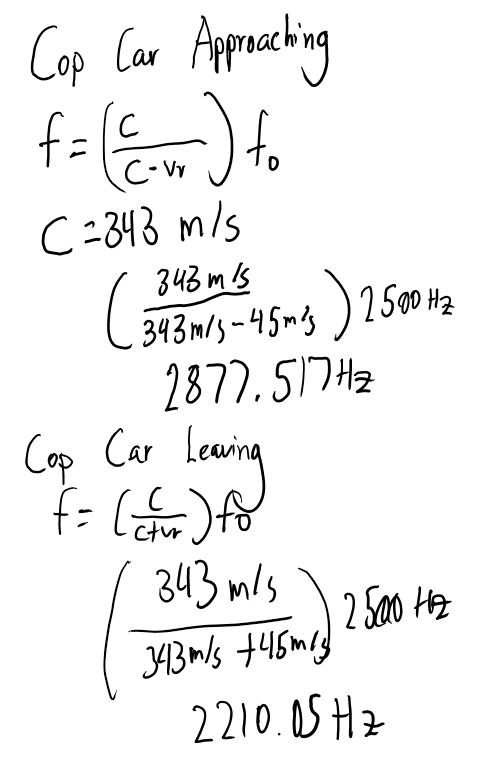Doppler Effect: Difference between revisions
| Line 27: | Line 27: | ||
A cop car drives at 45 m/s toward the scene of a crime, with its siren blaring at a frequency of 2500 Hz. At what frequency do people hear the siren as it approaches? At what frequency do they hear it as it passes? The speed of sound in the air is 343 m/s. | A cop car drives at 45 m/s toward the scene of a crime, with its siren blaring at a frequency of 2500 Hz. At what frequency do people hear the siren as it approaches? At what frequency do they hear it as it passes? The speed of sound in the air is 343 m/s. | ||
[[File: | [[File:SolutionforBrian.jpg]] | ||
==Connectedness== | ==Connectedness== | ||
Revision as of 23:38, 28 November 2017
This topic covers the Doppler Effect.
The Main Idea
The Doppler Effect is the change of wavelength or frequency of a wave whenever its source is moving relative to the observer. A real life example of the Doppler Effect is when a vehicle, for example an ambulance, passes by the observer and when the ambulance approaches, the pitch increases but after the ambulance passes by the observer, the sound drastically recedes, as shown in this YouTube video: https://www.youtube.com/watch?v=a3RfULw7aAY.
Explanation
The increase in frequency and smaller wavelength is due to the source of the waves moving towards the observer as each successive wave crest is emitted closer to the observer from the previous wave.
The drastic reduce of pitch after the source moves past the observer is due to the movement of the waves as seen in the image example below.
The Doppler Effect is not only shown in sound waves as in the example of the ambulance and the image above. But also with other waves such as water waves and light waves.
Formula
General Formula
- [math]\displaystyle{ f = \left( \frac{c + v_\text{r}}{c + v_\text{s}} \right) f_0 \, }[/math]
where
- [math]\displaystyle{ f{0} }[/math] is the emitted frequency;
- [math]\displaystyle{ f }[/math] is the observed frequency;
- [math]\displaystyle{ c \; }[/math] is the velocity of waves in the medium;
- [math]\displaystyle{ v_\text{r} \, }[/math] is the velocity of the receiver relative to the medium; positive if the receiver is moving towards the source (and negative in the other direction);
- [math]\displaystyle{ v_\text{s} \, }[/math] is the velocity of the source relative to the medium; positive if the source is moving away from the receiver (and negative in the other direction).
Examples
A cop car drives at 45 m/s toward the scene of a crime, with its siren blaring at a frequency of 2500 Hz. At what frequency do people hear the siren as it approaches? At what frequency do they hear it as it passes? The speed of sound in the air is 343 m/s.
Connectedness
- How is this topic connected to something that you are interested in?
- How is it connected to your major?
- Is there an interesting industrial application?
History
Put this idea in historical context. Give the reader the Who, What, When, Where, and Why.
See also
Further reading
Books, Articles or other print media on this topic
External links
Internet resources on this topic
- Sheldon's (From The Big Bang Theory) Explanation: https://www.youtube.com/watch?v=Y5KaeCZ_AaY
References
This section contains the the references you used while writing this page
http://www.physicsclassroom.com/class/waves/Lesson-3/The-Doppler-Effect
http://www.sparknotes.com/testprep/books/sat2/physics/chapter17section6.rhtml

